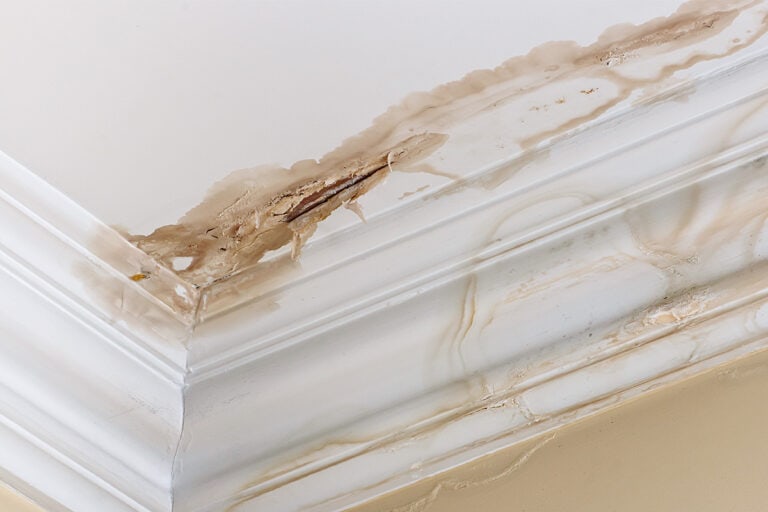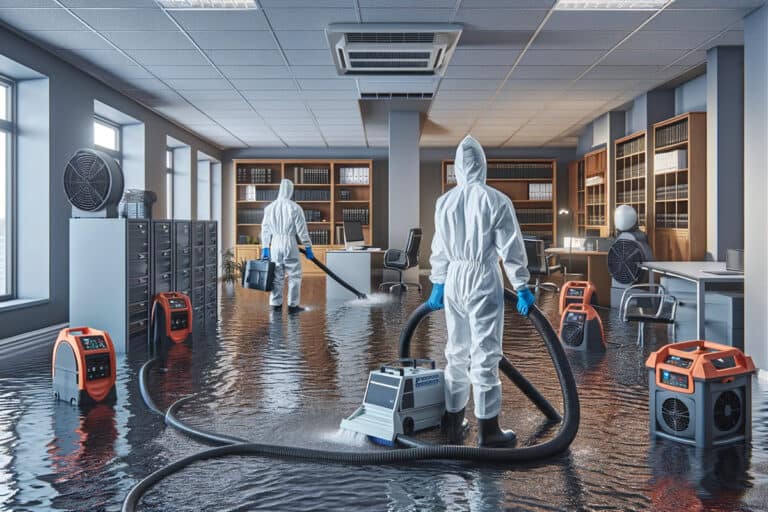Disclosure: I am compensated for purchases made through some links on this site. Click for details.
In the aftermath of flooding, promptly addressing water damage is critical to mitigating the impact on your property. Shop vacuums, or shop vacs, are a particularly effective tool in these scenarios, equipped to handle large volumes of water and debris. Before deploying a shop vac, it’s important to be familiar with its operation and ensure that all preliminary safety checks are conducted to avoid any electrical hazards.
Efficiently using a shop vac involves setting it up correctly, starting with the removal of filters that are designed for dry debris. As you begin the water extraction process, moving systematically through affected areas not only helps in thorough clean-up but also prepares the site for subsequent drying and repair. Post-extraction, it’s vital to attend to the water-damaged areas promptly to prevent mold growth and structural issues.
Key Takeaways
- Shop vacs are specialized tools for handling large volumes of water and require proper setup.
- A systematic approach to water extraction optimizes the clean-up process.
- Post-extraction actions are crucial for preventing further damage to the property.
Understanding Shop Vacs
Shop Vacs, also known as wet/dry vacuums, are specialized vacuum cleaners that can handle both dry debris and wet messes. They are an indispensable tool for dealing with water damage efficiently.
Types of Shop Vacs
There are several types of Shop Vacs to consider based on the scale of the job:
- Portable Wet/Dry Vacs: These are compact and easy to maneuver, suitable for quick cleanups.
- Heavy-Duty Wet/Dry Vacuums: Larger capacity and power for extensive water damage scenarios.
- Specialty Wet/Dry Vacs: Some models are designed for particular industries or tasks, with additional features like pumping capabilities.
Parts of a Shop Vac
A Shop Vac typically consists of these crucial components:
- Motor: Powers the suction.
- Drum: Container for holding dry debris or liquid.
- Hose: Flexible tube for suctioning material.
- Filter: Traps dirt and debris, with some designed for wet materials specifically.
Shop Vac vs. Regular Vacuum
Shop Vacs differ from regular vacuum cleaners in several key areas:
- Functionality: Shop Vacs can handle both wet and dry materials, whereas regular vacuums are usually only for dry surfaces.
- Power: Generally, Shop Vacs have stronger suction and a larger capacity to manage more demanding clean-up jobs.
- Construction: They are built with more robust materials to withstand tougher conditions.
Choosing a Shop Vac over a regular vacuum for water damage is crucial for effective cleanup.
Preparation for Water Removal
Before one begins the process of water removal after a flood, it is essential to tackle preparation with precision, focusing on safety precautions, a thorough assessment of the area, and the collection of appropriate equipment.
Safety Precautions
The foremost concern is safety, especially regarding electricity in a flooded environment. Individuals should ensure the power is turned off at the main breaker, and they should wear insulated gloves to protect against electrical shock. Using a GFCI (Ground Fault Circuit Interrupter) outlet to power the shop vac can provide an additional layer of electrical safety.
Assessing the Flooded Area
One must accurately assess the flooded area to understand the extent of water penetration and potential structural hazards. In cases of a flooded basement, determining water levels and identifying submerged obstacles can guide the strategic placement of the shop vac, avoiding any unforeseen problems during water extraction.
Gathering Necessary Equipment
The right equipment is vital for effective water removal. They should gather not just a shop vac suited for wet conditions, but also additional items such as buckets, mops, and squeegees. For substantial flooding, they may need hoses that can direct water to a suitable drainage area outside the flooded space.
Setting Up Your Shop Vac
Proper setup of a shop vac is critical for efficiently handling water removal after flooding. The user must select the appropriate filter, use suitable attachments, and ensure airflow is maintained to maximize the equipment’s effectiveness.
Choosing the Correct Filter
When preparing a shop vac for water pickup, one should remove the standard dry filter and replace it with a wet filter or foam sleeve designed for liquid messes. Ensuring the correct filter is in place will protect the motor from water damage and optimize the vacuum’s performance for water extraction.
Using Wet/Dry Vac Attachments
The right attachments can enhance a shop vac’s effectiveness in water-related scenarios. For large areas of standing water, one typically attaches a nozzle tailored for water collection, which concentrates suction and facilitates quicker cleanup. Smaller areas and crevices may require narrower attachments to ensure thorough water removal.
Ensuring Proper Airflow
Airflow is crucial for the shop vac’s operation; clogged hoses or overfilled tanks can impede this. The user must regularly check and clear the hose to prevent blockages and regularly empty the tank to maintain optimal suction power. Proper airflow will ensure the shop vac operates at peak efficiency for dealing with water damage.
Water Extraction Process
Effectively dealing with the aftermath of flooding involves a systematic approach to water extraction. The following steps outline the use of a shop vac to handle standing water, remove moisture from surfaces, and vacuum wet carpets.
Starting with Standing Water
To begin extracting standing water, ensure the shop vac is set to wet mode; remove the filter if it’s designed for dry vacuuming only. Starting at the deepest point, slowly move the nozzle through the water, allowing the shop vac to do its work. It is crucial to use a robust hose and appropriate attachment to maximize efficiency.
Addressing Water on Surfaces
After removing standing water, shift focus to other flat surfaces where water has pooled. Attachments like a squeegee or crevice tool can help in directing water toward the shop vac’s suction area, ensuring a more thorough removal. Avoid overloading the shop vac by monitoring the amount of water extracted and emptying the bin as needed.
Vacuuming Wet Carpets
When tackling wet carpets, the shop vac can be instrumental. Use a wet vac or an upholstery attachment to pull water out of the fibers. The process may need to be repeated several times for thorough extraction, and it’s advisable to move slowly across the carpet to allow the vacuum to absorb as much water as possible.
Post-Extraction Cleanup
Once the water has been extracted using a shop vac, properly cleaning and maintaining your equipment is essential to ensure it remains effective and safe for future use.
Emptying and Cleaning the Canister
Firstly, one should empty the canister into an appropriate drain or disposal area; avoid pouring contaminated water into storm drains or areas where it could cause environmental damage. Rinsing the canister with a mix of water and chlorine bleach will disinfect it, removing any residual contaminants. Ensure a thorough rinse with clean water afterward to remove any bleach residue.
Drying the Shop Vac Components
After cleansing, components must be completely dried to prevent mold and mildew growth. Air drying in a well-ventilated space is ideal. For a quicker process, wiping with a dry cloth or using an air compressor can be effective — particularly on intricate parts.
Filter and Hose Maintenance
Check the filter and hose for damage and debris. If the filter is reusable, clean it according to the manufacturer’s instructions, typically involving a gentle rinse; otherwise, replace it. Ensure the hose is free of obstructions by flushing with a bleach solution if necessary, followed by a thorough rinse and dry. Maintain regular maintenance to extend the lifespan and efficiency of your shop vac.
Handling Water-Damaged Areas
After flooding, immediate action is crucial to mitigate water damage, prevent mold and mildew, and start the restoration process. It is essential to use the correct techniques for drying and disinfecting the affected home areas to ensure safety and effectiveness.
Mold and Mildew Prevention
To prevent mold and mildew growth, one must act quickly. Flooding can lead to a perfect environment for mold if areas remain wet. They should start by removing standing water using a Shop Vac, then move swiftly to employ dehumidifiers and air filters to reduce moisture and improve air quality.
Drying and Disinfecting the Area
Once water is extracted, they need to thoroughly dry all surfaces. Fans and dehumidifiers play a pivotal role in pulling moisture from the floor and carpets. Next, disinfecting is necessary; they must use EPA-approved disinfectants to clean all water-touched surfaces, ensuring a sanitary environment post-water intrusion.
Restoration and Repair Tips
In the aftermath of water damage, safe and efficient restoration is paramount. If the home’s structure is compromised, they may need to consider professional water damage restoration services. For less severe cases, they can replace damaged materials like drywall and insulation to restore their homes to pre-flood conditions.
Advanced Shop Vac Features for Flooding
When dealing with water damage, a shop vac equipped with advanced features can greatly streamline the cleanup process. These functionalities not only increase efficiency but also enhance safety during operation.
Built-In Water Pump Utilization
Some shop vac models come with a built-in water pump, which is invaluable for the continuous removal of water without the need to manually empty the tank. The pump allows the user to transfer water directly to a sink or out through a window, making the process faster and less labor-intensive. It operates with the help of a float mechanism that triggers the pump when the water reaches a certain level, ensuring consistent water extraction.
Automatic Shut-Off Capabilities
For additional protection, many advanced shop vacs are equipped with an automatic shut-off feature. This system automatically powers down the unit when the capacity of the canister reaches its limit or when the float inside the tank rises to a preset level, preventing overflows and potential damage to the vacuum motor. This saves the user from constant monitoring, allowing them to focus on other aspects of flood recovery.
Handling Large-Scale Floods
For substantial water damage scenarios, high-capacity shop vacs are essential. These vacuums can hold a significant amount of water before requiring emptying, reducing downtime and increasing productivity during cleanup efforts. They can handle several gallons of water, making them suitable for residential or commercial flooding events. The presence of a large tank combined with a powerful motor means they can tackle extensive water-related messes efficiently.
Maintenance and Storage
Maintaining and storing a shop vac correctly extends its lifespan and ensures it remains ready for use. Proper practices protect the motor, filter, and hose from damage, while also preventing the accumulation of dust and debris.
Proper Storage Practices
When not in use, the shop vac should be stored in a dry, cool place to prevent the motor from humidity damage and to maintain the integrity of the hose. To prevent any residual dust or water from damaging the equipment, it’s crucial to empty the canister and clean the filter after each use.
Long-Term Maintenance Tips
Periodic checks are vital for prolonging the equipment’s lifespan and functionality. Users should regularly inspect the filter and replace it when necessary to avoid overloading the motor and to ensure efficient suction. Additionally, one should regularly examine the hose for any punctures or blockages that could impede performance.
Troubleshooting Common Issues
Should a loss of suction or unusual noise occur, it may indicate a clogged filter or a full canister. Users should first check these areas before examining the hose for obstructions. Motor problems, often suggested by a burning smell or unusual sounds, should be addressed promptly by consulting the manufacturer’s guidelines or seeking professional repair services.
Safety and Environmental Considerations
When dealing with the aftermath of flooding, prioritizing one’s safety and being mindful of the environment are crucial. Before initiating cleanup, ensure that electrical hazards are mitigated and understand the proper methods for disposing of water and debris.
Preventing Electric Hazards
Before using a shop vac to remove water, first make certain any appliances or electronic devices within the vicinity are unplugged, and the use of a Ground Fault Circuit Interrupter (GFCI) outlet is advisable when operating a shop vac. This device is specifically designed to prevent electric shock, adding an extra layer of safety during the cleanup process.
Proper Disposal of Debris and Water
A shop vac can efficiently remove not only water but also trash and grime that may have accumulated. It is important to dispose of this waste responsibly, adhering to local regulations to avoid any negative impact on the environment. Water extracted from a flood may be contaminated, and one must ensure its disposal doesn’t lead to further pollution of waterways or standing pools, which could exacerbate the initial water damage.
Conclusion
Using a shop vac to manage water and flooding damage requires careful attention to safety and efficiency.
Firstly, ensure the shop vac is empty and clean before starting your water removal task to prevent cross-contamination between dry and wet debris.
Secondly, exercising caution by turning off electricity and gas in affected areas can prevent accidents.
When tackling water damage cleanup, the user must prioritize safety and thoroughness. A methodical approach to extracting water, drying the area, and sanitizing surfaces helps reduce the risk of mold and structural damage. The user should remember that while a shop vac can be useful for small-scale water damage, larger floods may necessitate professional assistance.
The process can be time-consuming but acting swiftly and appropriately with the right equipment, such as a shop vac, can mitigate water damage significantly. They should also be aware that proper maintenance and care of the shop vac post-usage will ensure its longevity and readiness for future situations.





